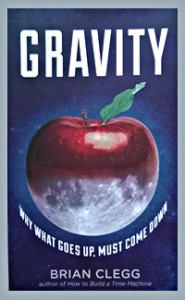Gravity
by Brian Clegg. Published by Duckworth Overlook www.ducknet.co.uk
Gravity is a curious beast. So weak that you can overcome a whole planetfull of the stuff with the energy in the muscles of your legs yet so powerful it controls the movements of worlds and stars and galaxies. It’s presence and effects in our lives are so ubiquitous we give this odd force no more thought than a fish gives to water.
The ancient Greeks were the first to grapple with gravity and Aristotle’s theory of ‘natural tendencies’ – a rock is attracted more to the earth than, say, a feather, because they are the same element – held sway until the middle ages and Copernicus and Galileo’s run-ins with the church. Clegg intertwines potted biographies of these great thinkers – at least where they are most relevant to their ideas – and continues the back-stories theme into modern times with Einstein’s ‘warped space’ take on gravity.
Many readers will be familiar with the story of Arthur Eddington’s observations of star positions during the 1919 total eclipse which were the pivotal proof for Einstein’s theory of warped space. Fewer perhaps will be aware of how carefully Eddington (a staunch supporter of Einstein) cherry-picked results to support the theory. Of all the photos taken by Eddington’s team on that cloudy day, only two were usable and only one was clear enough to show the expected shift in star positions. A simultaneous exhibition to Brazil gave very ambiguous readings. Overall, there was not enough data to either support or refute Einstein’s theory and it was only Eddington’s enthusiastic promotion that propelled Einstein to front-page fame. Bad science that just happened to be right!
Modern architects of String Theory don’t fare quite so well in the back story department (academia just isn’t as excitingly life-threatening as it was in the 16th Century) but here Clegg is not afraid to cover alternatives to that modern paradigm such as a Quantum Loop Gravity. I’d have like to see more exploration of these alternatives to string theory – which has produced no testable predictions in 30 years and which Clegg likens more to religion than science – but at least the reader is left in no doubt that modern gravity theory is far less monolithic than is sometimes presented.
Though pitched at a resolutely ‘popular’ level, ‘Gravity’ is not as science lite as some. Clegg is not afraid to throw in an occasional equation when needed (though it’s not necessary to solve them to enjoy the book) and you will also need to pay attention a bit during the latter chapters covering quantum theory, multiple dimensions, and Branes. I’m still not sure I’ve got my head round the concept of ‘spacial atoms’ that are not physical but just the ‘logical components of space’ (seriously physicists; math is a powerful tool but you’re starting to sound like you’re smoking the stuff. Maybe take a couple of grams of experiment to go along with those tons of theory?).
Here’s a quick quantum joke:
Why is M Theory like an exasperated parent?
Oh, becauseitjusis OK!
If you understand the joke, you’ll enjoy ‘Gravity’. If you don’t understand the joke don’t worry; you will after you’ve read ‘Gravity’.
